Introduction
This document describes the concept and the need behind the Cisco Smart Software Licensing for Cisco Unified Border Element (CUBE).
Prerequisites
Requirements
Cisco recommends that you have knowledge of these topics:
- Cisco IOS® XE feature sets and technology packages
- Network connectivity establishment
- File copy to Cisco IOS®
- Smart Licensing basics
- Classic Licensing model
- Knowledge of how to work CUBE, CME, SRST
Components Used
This document is not restricted to specific software and hardware versions.
The information in this document was created from the devices in a specific lab environment. All of the devices used in this document started with a cleared (default) configuration. If your network is live, ensure that you understand the potential impact of any command.
Background Information
Cisco Smart Software Licensing must remove entitlement barriers of today and provide information on your software install base in order to make it easier to buy, deploy, track, and renew Cisco software. You, your chosen partners, and Cisco can view your hardware, software entitlements, and eventually services in the Cisco Smart Software Manager (CSSM) interface. All Smart Software Licensed products, upon configuration and activation with a single token, must self-register, and remove the need to navigate to a website and register product after product with Product Activation Keys (PAKs). Instead of the use of PAKs or license files, Smart Software Licensing establishes a pool of software licenses or entitlements that can be used across your entire company in a flexible and automated manner. Pooling is particularly helpful with Return Materials Authorizations (RMAs) because it eliminates the need to re-host licenses. You can self-manage license deployment throughout your company easily and quickly in the Cisco Smart Software Manager. Through standard product offers, a standard license platform, and flexible contracts you have a simplified, more productive experience with Cisco software.
What is Smart Licensing?
Smart licensing is the new way to think about software licensing. It is a cloud-based license compliance repository and checker.
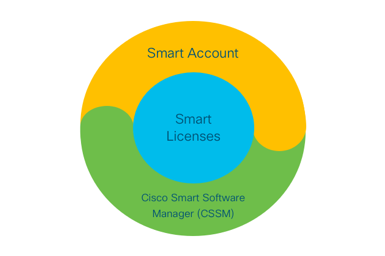
Components
- Smart Account: A Smart Account is used to create users and groups and organize licenses as per your business needs.
- Smart Licensing: At the core is Smart Licensing, a flexible approach that streamlines the management of your software licenses.
- CSSM: CSSM is an intuitive portal where you can activate and manage all your Cisco licenses.
How Does Smart Licensing Work?
All purchased licenses move directly into your Smart Account Products that are registered to the Smart Account and check if they are compliant. These Licenses are standalone (not tied to a product). It has a Software Inventory Management System that answers two questions:
- What have I purchased?
- What is it that I use?
Smart Licensing licenses you, not the Product Installation. The Licenses are pooled for the entire account/sub-account (Smart Account). These Licenses are not node-locked to a device which provides ease of registration and PAK elimination.
Operation
- Smart Licensing isnot an enforcement mechanism. It merely captures, and reports license ownership and consumption details as sent by a Cisco product.
- When a product instance starts up, it reports in and registers. Any time a new feature is requested, it checks in again.
- It also checks in periodically.
- Any use of features for which the product is not licensed is reported as qualified leads to sales teams.
Benefits
- Leverage a standard licensing platform in order to support a range of consumption models.
- Reduce cycle time with activation and registration that are automatic, instead of manual.
- Obtain visibility of software consumption (what is purchased and what is deployed) across your network.
- Eliminate the need for RMA or rehost action.
- Make changes within minutes, instead of days or weeks.
Capabilities and Features
All products automatically register upon installation and configuration. You do not need any PAKs or license key intervention. A cloud-based portal provides you visibility into what you have purchased and what you have deployed within your network. Licenses are no longer node-locked to your device. Through Smart Licensing you can also create license pools (a logical grouping of entitlements) in order to reflect your organizational structure.
Smart Licensing for CUBE
Activation:
- No PAK or RTUs
- Easy registration
- Accurate records of software license entitlements
- Licenses node-unlocked
- Licensing consistency across Unified Communications (UC) Products
Manage entitlements:
- Smart Software Manager is a cloud-based tool
- Virtual accounts to segment company assets based on business needs
- Pool licenses in order to distribute and use licenses
- Eliminates return material authorizations and re-hosting
- Flexible deployment options
- Alerts for timely recommendations via Smart Software Manager or E-mail
Reports
Entitlement:
- The entitlement report indicates the quantity of each license type purchased, in use, and a surplus or a shortage (overage)
- Maximize licenses that are utilized and enable you to see where assets are needed
Term-limited license:
- Full visibility to term-limited licenses and expiration dates
- Helps to plan a budget in order to purchase what and when needed
Product instance:
- Lists product instances in the smart and virtual accounts
- Control software usage with greater precision
CUBE Classic vs. New Smart Licensing Comparison
|
Old Classic Licensing (CUBE)
|
New Smart Licensing Offer (CUBE)
|
|
Complex offer:
- Tiered and multi-session bundle price (5/25/100)
- ISR or ASR-specific application entitlements
- Node-locked RTU licenses
- Not portable or must repurchase with new HW
- Difficult to track
|
Simplified offer:
- Per session entitlements – only pay for what is needed
- SWSS service is attached for support and portability
- Common licensing entitlements across Cisco ISR/ASR platforms
- Flexible Pooled entitlements
- Feature license borrowing (Standard/Redundant)
|
- Typically incorrectly provisioned or unknown usage
|
- Usage and non-compliance status
|
|
|
- New Features
- Lineside and Media Proxy
|
1. ISR = Integrated Service Router
2. ASR = Aggregation Services Router
3. RTU = Right-To-Use
4. HW = Hardware
5. SWSS = Cisco Software Support Service

License Backward Compatibility
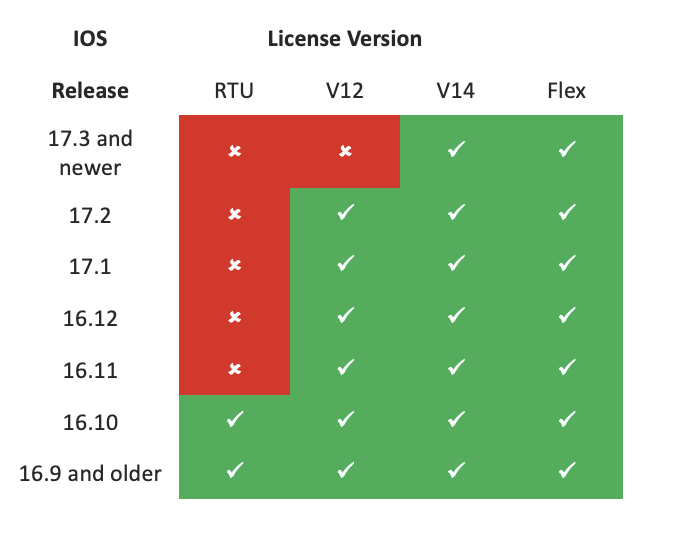
- In order to simplify the license purchase and management, current CUBE licenses provide entitlement to use all supported software releases
- You only need to hold the latest versions, regardless of the software used
- CSSM uses license hierarchies in order to deliver this functionality
Smart License Hierarchy
- Smart License Hierarchies allow available licenses with a higher entitlement to be used to cover a shortfall in lower-level licenses
- Hierarchies also allow later version licenses to entitle earlier systems
- On-premises license server (satellite) v7 or later is required in order to use license hierarchies

Platform Licensing
In order to run CUBE features, routers have a minimum platform license requirement. CUBE session licenses are required in addition to the use of the features.

These license configurations are required in order to access CUBE CLIs:
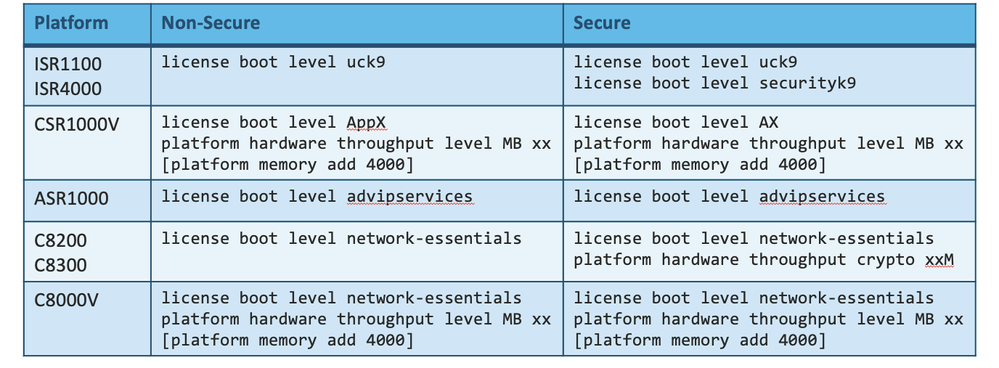
Note: For all Smart License versions, the CUBE license is not enforced. This means that as long as you have continued registration to CSSM if your licenses reach the 'Out of Compliance' state, your calls are still allowed. However, if the registration to CSSM drops, the Session Initiation Protocol (SIP) service is disabled and calls stop processing.
Since the release of 17.6.2, this behavior changed, where the SIP service does not get impacted by License Report Acknowledgements.
Smart Licensing Requirements by Release
The support for Smart Licensing started with Cisco IOS XE 16.10.1. In the Cisco IOS XE 17.3.2 and 17.4.1, support to a simplified method for Smart Licensing with the use of Policies mode only License was started.
|
IOS XE Release
|
Platform Requirements
|
CUBE Licensing
|
|
16.6.1 to 16.9.x
|
- Smart Licensing mode is optional
|
|
|
16.10.x
|
- Smart Licensing mode only
|
|
|
16.11.1a to 17.1.x
|
- Smart Licensing mode only
- Continued registration is required to enable CUBE features
|
- Smart Licensing only*
- Trunk license requests are set by manual configuration
- No license policing if out of compliance
- SIP processing disabled in the 'Eval-Expired' state
|
|
17.2.1r to 17.3.1a
|
- Smart Licensing mode only
- Continued registration is required in order to enable CUBE features
|
- Smart Licensing only*
- Trunk license requests are set dynamically by usage
- No license policing if out of compliance
- SIP processing disabled in the 'Eval-Expired' state
|
|
17.3.2 onwards
|
- Smart Licensing with the use of Policy mode only
- License use must be reported within the account policy to enable CUBE features
|
- Smart Licensing only*
- Trunk license use is measured periodically and reported as per the Smart Account policy
- In accordance with policy, license policing reports are not acknowledged (SIP processing is disabled otherwise)
|
License Configurations - Versions 16.11, 16.12, and 17.1
License consumption report in the Cisco IOS XE releases 16.11, 16.12, and 17.1 is manually configured with the use of these commands:
Router(conf)ig#voice service voip
Router(conf-voi-serv)#mode border-element license capacity <session_count>
With these releases, the license capacity report is both static and optional.
CUBE platforms must be registered to the Smart Licensing server, even if license capacity is not configured. Call processing is shut down if a platform is not registered and the evaluation period expires.
Call processing is neither limited if the number of sessions exceeds the license capacity configuration nor if the license request is ‘Out of Compliance’.
Some of the scenarios in this section describe license pooling with manual configuration. In order to ensure that the correct number of licenses are consumed from the virtual account, it is suggested that the average number of licenses required is configured on each device. The 'Configured for' information guides how to configure this.
Smart License - States
Registration State
- Registered
- Unregistered
- Registration Expired
- Unidentified (this state can be due to the entitlement tag mismatch when the router is upgraded from earlier versions to 16.11)
Authorization State
- Evaluation mode
- Evaluation expired
- Authorized
- Out of Compliance
- Authorization Expired
The evaluation period starts the moment a feature that requires entitlement is enabled. The evaluation period is counted while the agent is either in an unidentified or unregistered state. The evaluation period is not renewable (that is, it permanently ends when the countdown reaches 0). Authorization requests can result in either an Authorized or Out of Compliance response or a communication failure error. Authorization periods are renewed every 30 days with authorization requests. As long as the authorization response is either Authorized or Out of Compliance, the authorization period is renewed. Authorization expiration starts when the authorization period expires (that is, 90 days from the day authorization fails). While in the authorization expired state, the agent continues to retry for renewal with authorization requests. If the retry succeeds with Authorized or Out of Compliance, a new authorization period begins. If the certification ID fails to renew, the product instance goes to an unregistered state and starts to consume the evaluation period.
Use of Call Home
a. Enable CUBE with the use of this command:
Router(config)#voice service voip
Router(conf-voi-serv)#mode border-element license capacity <session_count>
b. Configure Call-home (this is available by default on all Cisco IOS XE releases later than 16.10.1a).
Service call-home
Call-home
profile “CiscoTAC-1”
active
destination transport-method http
no destination transport-method email
destination address http https://tools.cisco.com/its/service/oddce/services/DDCEService
c. Generate Token from CSSM:
Log in to Cisco CSSM > Inventory > Virtual Account > New Token
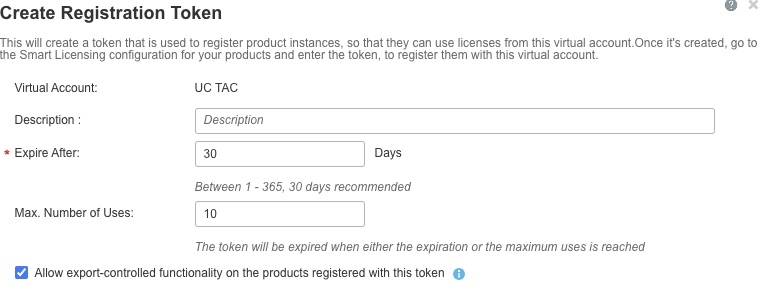
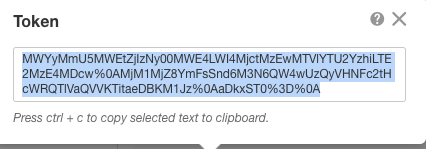
d. Register to CSSM:
Router#license smart register idtoken <id_token>
Use of On-Prem Satellite
This information is required in order to register a product instance to SSM On-Prem:
- SSM ON-PREM-URL: The SSM ON-PREM-URL is the Common Name (CN). The CN is set in the System Administration workspace within the Security Widget and is entered in the form of a Fully Qualified Domain Name (FQDN), hostname, or IP address of SSM On-Prem.
- Smart Transport URL: Smart-enabled product instances must be configured in order to send the registration request to SSM On-Prem. In order to do this, set either HTTP or HTTPS as the destination URL in the Smart Transport section of the product configuration that depends on the encryption used (HTTPS offers stronger encryption of communications than HTTP). The URL must be set to
https://<SSM ON-PREM-URL>:/SmartTransport or http://<SSM ON-PREM-URL>:/SmartTransport.
Note: HTTPS provides encrypted communication between a product and SSM On-Prem whereas HTTP provides clear text communication between a product and SSM On-Prem. Because of the stronger encryption capability, HTTPS is recommended unless there are issues with certifications set up.
- Smart Call-Home URL: Smart-enabled product instances must be configured in order to send the registration request to SSM On-Prem. This is accomplished when you set the destination HTTP URL in the Smart Call-Home configuration section of the product configuration. The URL must be set as shown:
Router(cfg-call-home-profile)#destination address https://<SSM ON-PREM-URL>:/Transportgateway/services/DeviceRequestHandler
or
Router(cfg-call-home-profile)#destination address http://<SSM ON-PREM-URL>:/Transportgateway/services/DeviceRequestHandler
- TOKEN-ID: The TOKEN-ID is used to associate the Product to the Specific Account and Local Virtual Account you chose on SSM On-Prem.
For more information on Smart Software Manager, see the Cisco Smart Software Manager User Guide.
Note: The IP or FQDN of SSM On-Prem must be the same on the URL and the CN setup on On-Prem Software.
Note: If you use CSSM On-Prem, do not upgrade beyond Cisco IOS XE 17.3.1 before you upgrade CSSM to version 8-202102 or later that supports policy reporting.
Use of Smart License Reservation
From the Cisco IOS XE Gibraltar 16.12.1, Smart License Reservation (SLR) is supported. SLR allows reservation and utilization of the Cisco smart licenses without the communication of the license information to CSSM. In order to reserve specific licenses for a device, generate a request code from the device. Enter the request code in CSSM along with the required licenses and their quantity, and generate an authorization code. Enter the authorization code on the device in order to map the license to the Unique Device Identifier (UDI).
In order to enable SLR for your device, you must execute these commands:
SR-I#enable
SR-I#configure terminal
SR-I(config)#license smart reservation
SR-I(config)#exit
SR-I#license smart reservation request local
Note: In order to cancel the License Reservation request, execute the license smart reservation cancel command.
Reserve Licenses with the Use of the Cisco Smart Software Manager
Step 1. Log in to the Cisco Smart Software Manager at https://software.cisco.com/#. You must log in to the portal with the use of the Cisco-provided username and password.
Step 2. Click the Inventory tab. From the Virtual Account drop-down list, choose your smart account.
Step 3. From the Licenses tab, click License Reservation as shown in this image.
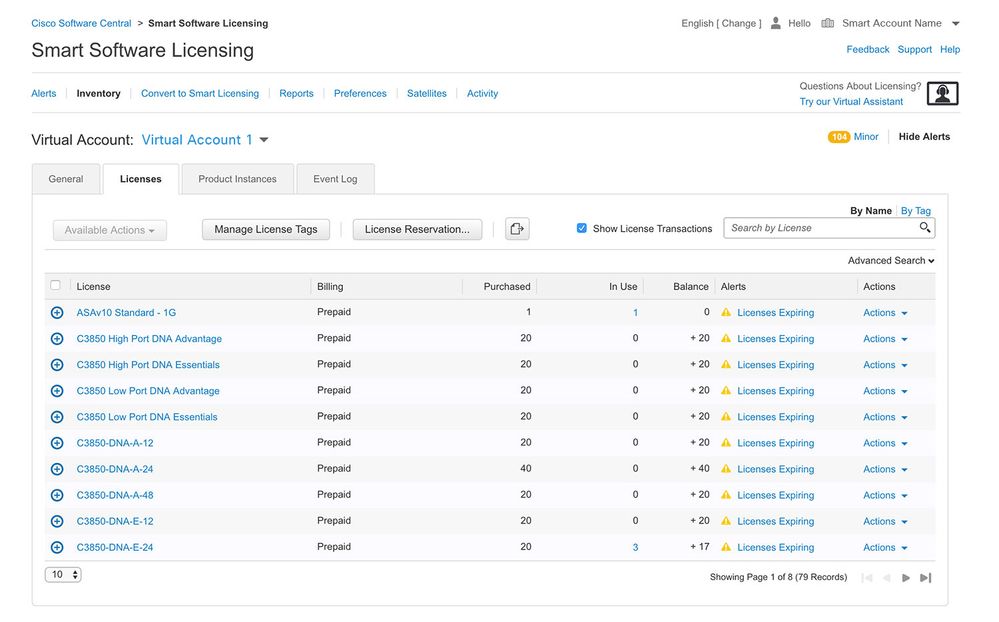
The system displays the Smart License Reservation wizard.
Step 4. On the Enter Request Code page, enter or attach the reservation request code you generated from the router, and click Next.
Step 5. Check the Reserve a Specific Licensecheck box. The system displays the list of surplus licenses available in your Virtual Account. Enter the number of licenses that you want to reserve for the required license, in the Quantity to Reserve field and click Next.
Step 6. From the Review and Confirm tab, click Generate Authorization Code.
Note: After you generate the SLR code for a specific device, the authorization code file is valid till you install the code. If the installation fails, you must contact Global Licensing (GLO) in order to generate a new authorization code.
The system displays the Authorization Code that is generated.
Step 7. Click the Copy to Clipboard option in order to copy the code, or download it as a file. You must copy the code or file to your device. If you configure SLR, you can download or install the authorization code text file. If you configure Permanent License Reservation (PLR), you can copy and paste the authorization code.
Register the Device with the Use of the Authorization Code
After you get the authorization code from CSSM, execute these commands in order to complete the license reservation procedure:
Step 1. Enable.
Enables privileged EXEC mode. Enter your password, if prompted.
Step 2. License smart reservation install file bootflash: <authfile.txt>.
This command registers the device. The authorization code you copied as a file is used to activate the SLR for your device. When you run the show license tech supportcommand, the system displays the details of the reserved licenses.
Deactivate Smart License Reservation
Router#license smart reservation return local
This command removes the authorization code and the device transitions back to the unregistered state. A return code is generated and must be entered in the Cisco Smart Software Manager in order to remove the product instance Router(config)#no license smart reservation.
For more details, refer to the Specific License Reservation Guide.
SLR is not supported after the 17.3.2 or 17.4.1 versions. The configuration must be removed in order to successfully configure the Smart Licensing. This command must be disabled if found in the configuration Router(config)#no license smart reservation.
Also, before you upgrade from an SLR-supported release to a non-SLR-supported release (17.3.2 and later), ensure the SLR is removed from Portal and Platform.
Note: Device Led Conversion (DLC) is required in order to migrate your current hardware platform licenses to a smart account.
Device-Led Conversion
DLC is the process where a new device or a product instance is upgraded from a Traditional to a Smart Licensing when registered in the CSSM. All licenses on the device automatically convert from a Classic or a Perpetual Right-to-Use (RTU) License to a Smart License without the need for any manual conversion.
Proceed with these steps in order to initiate the DLC.
Remember that the DLC can only be run once per router. Ensure that you are registered to the Smart Account where you want the licenses deposited first.
If you upgrade from an earlier Cisco IOS pre-universal feature release, upgrade to a universal non-Smart License only release (for example, Cisco IOS XE 16.9) first and configure your purchased licenses, then upgrade to the SLR.
The DLC is automatic if you upgrade directly from the RTU to release later than 17.3.2 directly.
Version 17.2.1r, 17.3, and 17.3.1a
From the Cisco IOS XE, 17.2.1r CUBE trunk session use is continuously monitored in order to report license usage periodically. This applies to the reporting of Standard and Redundant or Enhanced licenses. License use is reported periodically based on a timer which can be configured with the use of this command
voice service voip
mode border-element license periodicity [mins|hours|days]
If the periodicity timer is not configured, license usage is reported every seven days. The reporting period must be set to reflect the load-balancing trends in order to make the best use of the pooled licenses. Periodicity of less than one day must only be used when you register to an on-premises (Satellite) license server. The mode border-element license capacity option is deprecated from 17.2.1r. The calls continue to be processed if the licenses are 'out of compliance' (no license policing).
CUBE monitors the number of calls that are processed every second and uses this data in order to report the license use.
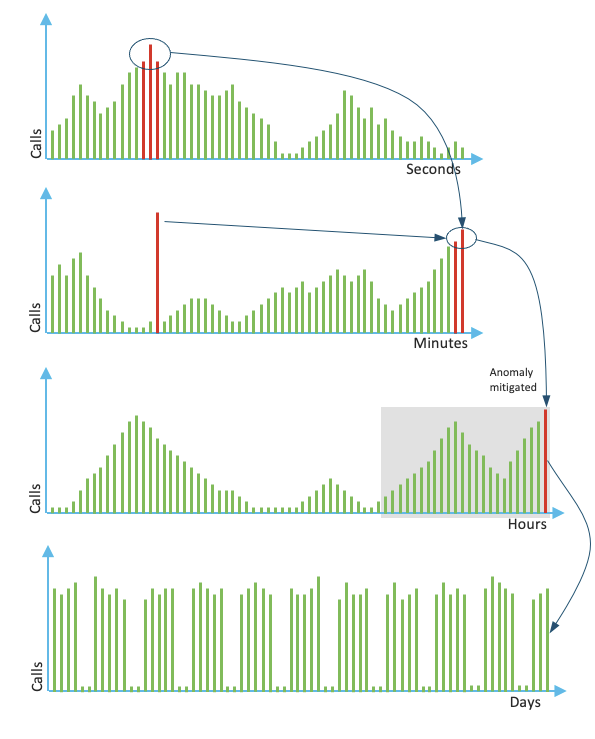
The use for each minute is the average of the top three measurements in the last 60 seconds. The use for each hour is the average of the top three measurements in the last 60 minutes. The daily use is the maximum of the last 24-hour values. The monitor license has been used for the last 72 days with the use of the show voice sip license stats command.
Versions 17.3.2 and Later
From Cisco IOS XE 17.3.2 onwards, Smart Licensing Enhancement (SLE) was introduced. Device registration is no longer required for new installs before use. The evaluation mode is removed. A report of which licenses have been used must be submitted based on the account policy. The CUBE license use must be reported within 90 days of a change in the number of sessions used. Reports are submitted directly to CSSM or via CSSM On-Prem (satellite) as before, or manually for disconnected networks with the use of a standalone reporting application Cisco Smart License Utility Manager (CSLU). It is also possible to report via the Cisco Digital Network Architecture (Cisco DNA) Center. Each submitted report must be acknowledged by CSSM. If the platform does not receive a valid acknowledgment within the policy reporting period, the SIP services are disabled (similar to when you observe the evaluation expiry previously).
The mode border-element license periodicity command now allows a minimum value of eight hours.
New timers are introduced in SLE in order to handle the utilization reporting from the CUBE Application > Smart Agent Application > CSSM.
- Top of the hour Timer (THT): This timer starts as soon as the router boots up and runs until the future top of the hour is reached.
For example, if the router boots up at 05:52 hours, CUBE waits till it reaches the future top of the hour, that is, 06:00 hours before it generates and sends the utilization report to Smart Agent.
- Variance Detection Timer (VDT): This timer starts as soon as the router boots up and polls for utilization once the THT is reached and polls every hour from then until the Periodicity Timer (PT) has elapsed. This timer is used in order to detect the utilization variance between the reports.
For example, if the router boots up at 05:52 hours, the first VDT poll for utilization triggers at 06:00 (THT) hours for the previous eight minutes.
- PT: This is the configured frequency in order to report the usage from CUBE to Smart Agent. The default value continues to be seven days as earlier but the minimum configurable value is changed to eight hours. An error is displayed if the PT is configured for anything less than eight hours and PT defaults to seven days.
Additional Methods
Additional methods are introduced in version 17.3.2 and later in order to establish trust between the device and the CSSM.
SLE Reporting
CUBE reports the license utilization to the Smart Agent at the THT expiry after boot. CUBE checks the license utilization at every VDT (one-hour) expiry. If the variance (delta) is less than 25% of the previous utilization report and PT is expired, CUBE reports the utilization to the smart agent.
If the variance (delta) is greater than 25% of the earlier utilization report, the Smart Agent updates the Resource Utilization Measurement (RUM) report and the PT is reset to the configured duration and restarted.
At the expiry of the Dispatch Timer as per policy, Smart Agent sends the RUM report to CSSM.
CSSM must respond with an Acknowledgement (ACK). If ACK fails, Smart Agent notifies CUBE about the ACK failure and SIP services are disabled.
SLE Transport
From 17.3.2, the usage of license smart register id token and license smart deregister are deprecated, and the new CLI license smart trust id token <token to add>show license all, show license status, and show license tech support are updated not to reflect anything on registration.
There are multiple transport modes of support added as part of SLE in order to support all customers.
Smart
The device can send the RUM report directly over the internet to CSSM. Prerequisites for both Smart and Call-home are the same as mentioned:
- CSSM must be reachable to the device.
- Domain Name Server (DNS) IP address must be configured in the device, with the command:
Router(config)#ip name-server <dns server IP address>
- A Respective Route must be configured in the device in order to reach CSSM. You can verify when you ping
smartreceiver-stage.cisco.com from the device, provided Internet Control Message Protocol (ICMP) is not blocked in the network.
- Configure domain name and domain lookup interface. These are the configuration commands:
Router(config)#ip domain name cisco.com
Router(config)#ip domain lookup source-interface <interface name> (Interface name by which CSSM can be reachable)
- Configure the IP HTTP source interface with this command:
Router(config)#ip http client source-interface <interface name>
- Configure Transport type.
Router(config)#license smart transport smart
Router(config)#license smart url smart https://smartreceiver.cisco.com/licservice/license
- Generate Token from CSSM:
Log in to Cisco CSSM > Inventory. Choose Virtual Account > New Token.
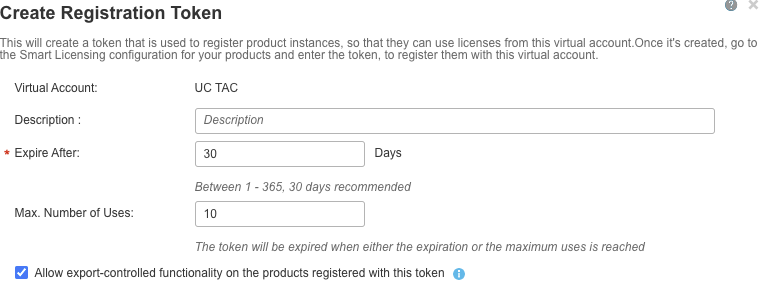
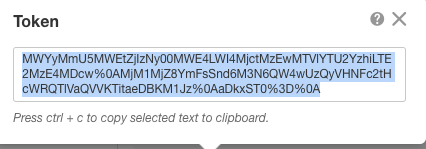
Router#license smart trust idtoken <token> local
Call Home
This is an HTTPS proxy device that collects the usage report from the device and sends it to CSSM.
a. Set Transport to Call-Home.
Router(config)#license smart transport callhome
b. Configure Call-home (this is available by default on all Cisco IOS XE releases later than 16.10.1a).
Service call-home
Call-home
profile “CiscoTAC-1”
active
destination transport-method http
no destination transport-method email
destination address http https://tools.cisco.com/its/service/oddce/services/DDCEService
c. Generate Token from CSSM:
Log in to Cisco CSSM > Inventory. Choose Virtual Account > New Token.
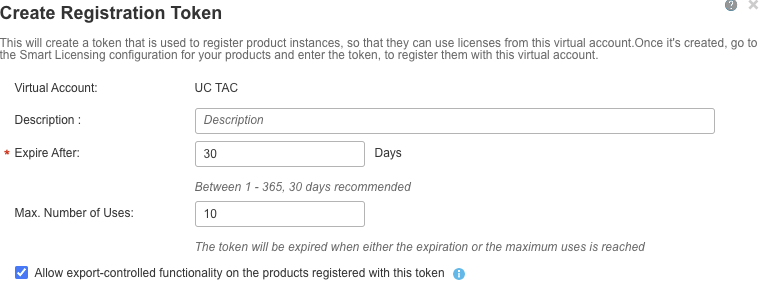
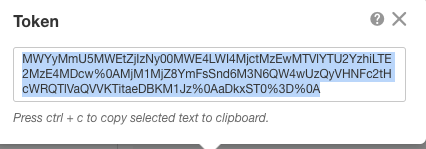
d. Establish Trust with CSSM.
Router#license smart trust idtoken <token> local
Note: The license smart trust idtoken <token> local force
Cisco Smart License Utility Manager (CSLU)
CSLU software can be installed as an application in Windows/Linux/Mac OS. It is also an in-built module in the satellite server that collects RUM reports from the Smart Agent and sends them to CSSM. CSLU software can be downloaded from Smart Licensing Utility. The CSLU must be reachable from the device.
Here are the CLIs related to the transport configuration:
CUBE(config)#license smart transport cslu
CUBE(config)#license smart url cslu http://<cslu-ip>:8182/cslu/v1/pi (FQDN also can used)
example of CLI- license smart url cslu http://10.195.85.83:8182/cslu/v1/pi where 10.195.85.83 is CSLU IP.
In this case, license smart trust idtoken CLI is not required, as a trusted connection must be established between CSLU and CSSM.
Note: When you upgrade to 17.3.2 or later, the transport type changes to CSLU and breaks CSSM trust and you must enable it again.
Airgap/Offline Method
When there is an airgap network or device that can not reach CSSM, the offline method can be used to send the RUM report and get ACK installed on the device. There is no connectivity between the device and CSSM is available. In this case, the airgap method is used to send the RUM report and get the ACKs from CSSM.
Here, whenever you want to update the license usage, you must collect the license usage files from the device and upload them to CSSM. Then, generate the ACK files in CSSM and upload them to the device. Even in the case of HA setup, collection of the usage on 'active' is sufficient.
Step 1. Enable transport:
CUBE(config)#license smart transport off (transport must be off for offline mode)
Step 2. Generate RUM report:
CUBE#license smart save usage unreported file <bootflash:file_name>
The option 'unreported' as shown, is recommended to be used. This downloads only the files that are yet to be reported and, discards old usage reports that were Acknowledged.
However, there are other options available for the amount of data that must be reported.
CUBE#license smart save usage ?
all Save all reports
days Save reports from last n days
rum-Id Save an individual RUM report
unreported Save all previously un reported reports
Step 3. Upload the report to CSSM:
Export the 'save usage data' from Routers Flash to the desktop. On the CSSM Smart Account page, navigate to Report > Usage Data Files > Upload usage data. In the pop-up window, choose the usage report and click upload. Once the file is uploaded, you must choose the correct Virtual Account (VA) with which the device is associated.
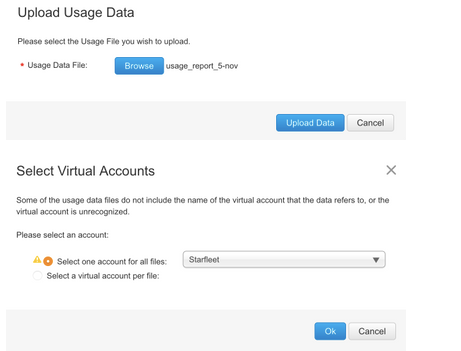
Step 4. Upload ACK on the router:
Once the data is processed completely and ACK is ready, download the file from the portal and load it onto Routers Flash. The command to import the ACK file into the device is:
CUBE#license smart import bootflash:<file_name>
Import Data Successful
SLE Enforcement
If a license usage report is not acknowledged before the acknowledgment deadline is set by the account policy, call processing is disabled. Check the current deadline with the use of show license status | i deadline. The call processing is only resumed when an acknowledgment is received from CSSM – directly, or indirectly via SSM On-Prem or CSLU.
Note: A change of policy after call processing has been disabled is not sufficient to resume services.
DLC is automatic if you upgrade directly from RTU to release later than 17.3.2.
Verify
Commands to Verify the Platform Registration
Use these commands in order to verify the platform registration and license usage with Cisco IOS XE releases 16.11.1a to Cisco IOS XE Amsterdam 17.3.1a:
show cube status
Note: From Cisco IOS XE Amsterdam 17.2.1r, the Licensed Capacity and blocked call information is no longer included in the output.
cube#show cube status
CUBE-Version: 12.5.0
SW-Version: 16.11.1, Platform CSR1000V
HA-Type: none
Licensed Capacity: 10
Calls blocked (Smart Licensing Not Configured): 0
Calls blocked (Smart Licensing Eval Expired): 0
show license status
If the platform is registered on CSSM/On-Prem satellite:
cube#show license status
Smart Licensing is ENABLED
...
Transport: > This shows the current transport type used
Type: Callhome
Registration:
Status: REGISTERED > This shows Smart License is registered
Smart Account: BU Production Test
Virtual Account: CUBE Sat Test
Export-Controlled Functionality: Allowed
Initial Registration: SUCCEEDED on Feb 18 12:57:04 2019 UTC
Last Renewal Attempt: None
Next Renewal Attempt: Aug 17 12:57:03 2019 UTC
Registration Expires: Feb 18 12:51:49 2020 UTC
License Authorization:
Status: AUTHORIZED on Mar 04 15:11:54 2019 UTC
Last Communication Attempt: SUCCEEDED on Mar 04 15:11:54 2019 UTC
Next Communication Attempt: Apr 03 15:11:53 2019 UTC
Communication Deadline: Jun 02 15:06:21 2019 UTC
If the platform is not registered:
show license status
Smart Licensing is ENABLED
Utility:
Status: DISABLED
Data Privacy:
Sending Hostname: yes
Callhome hostname privacy: DISABLED
Smart Licensing hostname privacy: DISABLED
Version privacy: DISABLED
Transport:
Type: Callhome
Registration:
Status: UNREGISTERED
Export-Controlled Functionality: NOT ALLOWED
License Authorization:
Status: EVAL MODE
Evaluation Period Remaining: 74 days, 21 hours, 30 minutes, 39 seconds > This also shows the evaluation period that remains. After the evaluation is expired, SIP services are disabled.
License Conversion:
Automatic Conversion Enabled: False
Status: Successful on May 03 19:13:32 2021 UTC
Export Authorization Key:
Features Authorized:
<none>
Miscellaneous:
Custom Id: <empty>
If the Platform is registered with the use of SLR:
ankvijay_vcme#show license status
Smart Licensing is ENABLED
Utility:
Status: DISABLED
License Reservation is ENABLED
Data Privacy:
Sending Hostname: yes
Callhome hostname privacy: DISABLED
Smart Licensing hostname privacy: DISABLED
Version privacy: DISABLED
Transport:
Type: Callhome
Registration:
Status: REGISTERED - SPECIFIC LICENSE RESERVATION
Export-Controlled Functionality: ALLOWED
Initial Registration: SUCCEEDED on May 03 18:49:23 2021 UTC
License Authorization:
Status: AUTHORIZED - RESERVED on May 03 18:49:23 2021 UTC
Export Authorization Key:
Features Authorized:
<none>
show voice sip license stats
cube#show voice sip license stats
11:01:01 AM Thursday Aug 29 2019 IST
10
9
8
7
6
5
4
3
2
1
0....5....1....1....2....2....3....3....4....4....5....5....6
0 5 0 5 0 5 0 5 0 5 0
CUBE Trunk License Usage (last 60 seconds)
369863146641
8880900440044
3330922440011
910 **
820 #*
730 ##
640 *##* **
550 ###* ##
460 #### *##*
370 *#### *##*
280 #####* ####
190 ###### ####
100 *######*####*
10 #############
0....5....1....1....2....2....3....3....4....4....5....5....6
0 5 0 5 0 5 0 5 0 5 0
CUBE Trunk License Usage (last 60 minutes)
* = maximum # = average
This example output is truncated to display 60-second and 60-minute tables only.
cube#show voice sip license stats table
02:50:16 PM Wednesday Nov 13 2019 UTC
CUBE Trunk License Usage (last 60 seconds)
Period Average Max
----------------------------
1-5 0 0
6-10 0 0
11-15 0 0
16-20 0 0
21-25 0 0
26-30 0 0
31-35 0 0
36-40 0 0
41-45 0 0
46-50 0 0
51-55 0 0
56-60 0 0
CUBE Trunk License Usage (last 60 minutes)
Period Average Max
----------------------------
1-5 0 0
6-10 0 0
11-15 0 0
16-20 0 0
21-25 0 0
26-30 0 0
31-35 0 0
36-40 0 0
41-45 0 0
46-50 324 900
51-55 343 899
56-60 292 600
show voice sip license status
cube#show voice sip license status
Host Name: cube
Current Time: Nov 25 2019 14:46:41 IST
SIP service: Up
License request interval: 5 Minute(s)
Next request at: Nov 25 2019 14:50:44 IST
Recent request(s) for entitlement tag CUBE_T_STD
-----------------------------------------------------------
Timestamp Count Result
-----------------------------------------------------------
Nov 25 2019 14:45:44 IST 10 Out of compliance
Nov 25 2019 14:40:44 IST 4 Authorized
Nov 25 2019 14:35:44 IST 2 Authorized
show license usage
cube#show license usage
License Authorization:
Status: AUTHORIZED on Mar 04 15:11:54 2019 UTC
CSR 1KV APPX 500M (appx_500M):
Description: CSR 1KV APPX 500M
Count: 1
Version: 1.0
Status: AUTHORIZED
Export status: NOT RESTRICTED
CUBE_Trunk_Standard_Session (CUBE_T_STD):
Description: Cisco Unified Border Element (CUBE) Trunk Standard Session License
Count: 10
Version: 1.0
Status: AUTHORIZED
Export status: NOT RESTRICTED
show license summary
Device#show license summary
Smart Licensing is ENABLED
Registration:
Status: REGISTERED
Smart Account: BU Production Test
Virtual Account: CUBE Sat Test
Export-Controlled Functionality: Allowed
Last Renewal Attempt: None
Next Renewal Attempt: Aug 17 12:57:04 2019 UTC
License Authorization:
Status: AUTHORIZED
Last Communication Attempt: SUCCEEDED
Next Communication Attempt: Apr 03 15:11:54 2019 UTC
License Usage:
License Entitlement tag Count Status
-----------------------------------------------------------------------------
CUBE_Trunk_Standard_... (CUBE_T_STD) 10 AUTHORIZED
Use these commands in order to verify the platform license usage from Cisco IOS XE Amsterdam 17.3.2 and Cisco IOS XE Bengaluru 17.4.1a onwards:
show cube status
cube#show cube status
CUBE-Version : 14.1
SW-Version : 17.3.2, Platform CSR1000V
HA-Type : none
cube#show cube status
CUBE-Version : 14.1
SW-Version : 17.4.1, Platform CSR1000V
HA-Type : none
show license status
If communication between CSSM and the platform does not work:
cube#show license status
Utility:
Status: DISABLED
Data Privacy:
Sending Hostname: yes
Callhome hostname privacy: DISABLED
Smart Licensing hostname privacy: DISABLED
Version privacy: DISABLED
Transport: > Different Transport types (cslu/smart/off/callhome) are visible here
Type: Callhome
Policy:
Policy in use: Merged from multiple sources.
Installed Time: Jan 01 05:30:00 1970 IST
Reporting ACK required: yes
Perpetual Attributes:
First report requirement (days): 365 (CISCO default)
Reporting frequency (days): 90 (CISCO default)
Report on change (days): 90 (Product default)
Subscription Attributes:
First report requirement (days): 90 (CISCO default)
Reporting frequency (days): 90 (CISCO default)
Report on change (days): 80 (Product default)
Enforced License Attributes:
First report requirement (days): 90 (Customer Policy)
Reporting frequency (days): 90 (Customer Policy)
Report on change (days): 80 (Customer Policy)
Export License Attributes:
First report requirement (days): 90 (Customer Policy)
Reporting frequency (days): 90 (Customer Policy)
Report on change (days): 90 (Customer Policy)
Miscellaneous:
Custom Id: <empty>
Usage Reporting:
Last ACK received: <none> > NO ACK Received from portal
Next ACK deadline: May 26 08:24:45 2020 IST
Reporting Interval: 30
Next ACK push check: <none>
Next report push: Jun 15 08:24:45 2020 IST
Last report push: <none>
Last report file write: <none>
Last report pull: <none>
Trust Code Installed: <none> > No trust code installed
If communication works correctly between CSSM and Platform:
isr4321#show license status
Utility:
Status: DISABLED
Smart Licensing Using Policy:
Status: ENABLED
Data Privacy:
Sending Hostname: yes
Callhome hostname privacy: DISABLED
Smart Licensing hostname privacy: DISABLED
Version privacy: DISABLED
Transport:
Type: Callhome
Policy:
Policy in use: Merged from multiple sources.
Reporting ACK required: yes (CISCO default)
Unenforced/Non-Export Perpetual Attributes:
First report requirement (days): 365 (CISCO default)
Reporting frequency (days): 0 (CISCO default)
Report on change (days): 90 (CISCO default)
Unenforced/Non-Export Subscription Attributes:
First report requirement (days): 90 (CISCO default)
Reporting frequency (days): 90 (CISCO default)
Report on change (days): 90 (CISCO default)
Enforced (Perpetual/Subscription) License Attributes:
First report requirement (days): 0 (CISCO default)
Reporting frequency (days): 0 (CISCO default)
Report on change (days): 0 (CISCO default)
Export (Perpetual/Subscription) License Attributes:
First report requirement (days): 0 (CISCO default)
Reporting frequency (days): 0 (CISCO default)
Report on change (days): 0 (CISCO default)
Miscellaneous:
Custom Id: <empty>
Usage Reporting:
Last ACK received: Jul 28 11:23:22 2021 PDT > Ack Received from CSSM
Next ACK deadline: <none>
Reporting push interval: 0 (no reporting)
Next ACK push check: Jul 28 11:26:20 2021 PDT
Next report push: <none>
Last report push: Jul 28 11:22:21 2021 PDT
Last report file write: <none>
Trust Code Installed: Jul 28 11:18:43 2021 PDT
show voice sip license statsshow voice sip license stats and show voice sip license stats tables are unchanged for a Policy that uses Smart Licensing. See earlier examples.show voice sip license status
Note: In the show voice sip license status
router#show voice sip license status
Host Name: router
Current Time: Sep 1 2020 23:12:03 UTC
SIP service: Up
License use recorded every: 8 Hour(s)
Next record at: Sep 2 2020 03:00:00 UTC
Recent use of license(s) for entitlement tag CUBE_T_STD
----------------------------------------------------------------------------
Timestamp Count
----------------------------------------------------------------------------
Sep 1 2020 19:00:00 UTC 0
Sep 1 2020 11:00:00 UTC 20
show license usage - displays the license usage.
POD8-4321-1#show license usage
License Authorization:
Status: Not Applicable
uck9 (ISR_4321_UnifiedCommunication):
Description: uck9
Count: 1
Version: 1.0
Status: IN USE
Export status: NOT RESTRICTED
Feature Name: uck9
Feature Description: uck9
Enforcement type: NOT ENFORCED
License type: Perpetual
appxk9 (ISR_4321_Application):
Description: appxk9
Count: 1
Version: 1.0
Status: IN USE
Export status: NOT RESTRICTED
Feature Name: appxk9
Feature Description: appxk9
Enforcement type: NOT ENFORCED
License type: Perpetual
securityk9 (ISR_4321_Security):
Description: securityk9
Count: 1
Version: 1.0
Status: IN USE
Export status: NOT RESTRICTED
Feature Name: securityk9
Feature Description: securityk9
Enforcement type: NOT ENFORCED
License type: Perpetual
show license summary
Device#show license summary
License Usage:
License Entitlement tag Count Status
-----------------------------------------------------------------------------
CUBE_T_STD (CUBE_T_STD) 9 IN USE
These commands are also available related to your Smart License:
show license allshow license tech supportshow call-home smart-licensing
Serviceability
Smart Licensing (Version 16.10.1a to 17.3.1a)
Syslog
When the evaluation period is about to expire, a Syslog alert is printed at various intervals. The alert is generated at these intervals: 60 days, 30 days, 21 days, 14 days, 7 days, and every day after, 23 hours, and every hour for the last day.
000295: *Apr 24 21:28:28.838: %SIP-3-LICENSING: The evaluation period is about to expire in 20 hours!
When the evaluation period has expired, you print the Syslog every time you get a 'SmartAgentNotifyEvalExpired' notification.
000335: *Apr 10 11:20:10.225: %SIP-3-LICENSING: Evaluation period has expired!
When the evaluation period has expired and sip-to-sip calls are blocked, a Syslog alert is printed.
005454: Jul 19 07:06:44.324: %CUBE-1-LICENSING: SIP-SIP call blocked due to CUBE Licensing Enforcement
Show call-home smart licensing statistics
Success: Successfully sent and response received.
Failed: Failed to send or respond indicated error occurred.
In-queue: In the queue waiting to be sent.
Dropped: Dropped due to incorrect call-home configuration.
�
Msg Subtype Success Failed Inqueue Dropped Last-sent (GMT+00:00)
----------------------------------------------------------------------
REGISTRATION 1 0 0 0 2019-02-05 03:06:22
ACKNOWLEDGEMENT 1 0 0 0 2019-02-05 03:06:25
ENTITLEMENT 2 0 0 0 2019-02-05 03:07:23
Show cube status
SW-Version : 16.11.1prd6, Platform CSR1000V
HA-Type: none
Licensed Capacity: 25
Calls blocked (Smart Licensing Not Configured): 0
Calls blocked (Smart Licensing Eval Expired): 0
SLE (Version 17.3.2 and Later)
Show voice sip license status
CUBE4431# show voice sip license status

In the first THT expiry, seven calls were reported and there was license variance usage that was less than 25% till the PT expired (8 hours). So, from 06:00:00 to 14:00:00 hours, maximum usage is reported as eight. From 14:00:00 hours to 15:00:00 hours and later every hour the variance was greater than 25%, hence you can see more entries.
Show voice sip license status
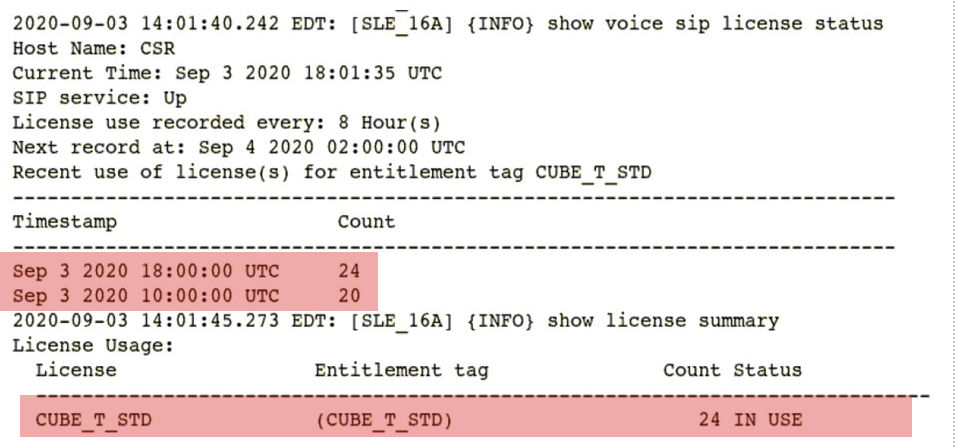
Here, the traffic was less than 25% till the PT timer expired, hence there are only two entries for 8 8-hour duration.
Troubleshoot
When you migrate to a Cisco device to a Smart Licensing enabled software version, this flowchart can be used as a general guide for all three methods (Direct Cloud Access, HTTPS Proxy, and Cisco Smart Software Manager On-Prem).
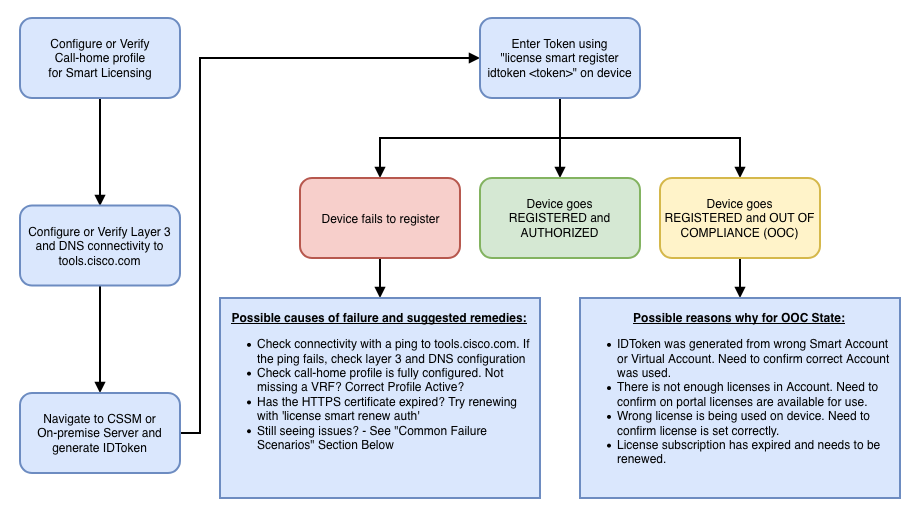
These troubleshooting steps mainly concentrate on a scenario in which the 'device fails to register'.
Device Fails to Register
After initial configuration, in order to enable Smart Licensing, the Token, which is generated on CSSM or Cisco Smart Software Manager On-Prem, must be registered on the device via CLI:
license smart register idtoken <TOKEN>
This must generate these events:
! Smart licensing process starts
!
The registration process is in progress. Use the show license status command to check the progress and result!
! Crypto key is automatically generated for HTTPS communication
!
Generating 2048 bit Rivest-Shamir-Addleman (RSA) keys, keys are exportable... [OK] (elapsed time was 1 second) %CRYPTO_ENGINE-5-KEY_ADDITION: A key named Service Level Agreement (SLA)-KeyPair has been generated or imported by crypto-engine %PKI-4-NOCONFIGAUTOSAVE: Configuration was modified. Issue 'write memory' to save the new Cisco IOS PKI configuration!
! Call-home start the registration process
! %CALL_HOME-6-SCH_REGISTRATION_IN_PROGRESS: SCH device registration is in progress. Call-home polls SCH server for registration result. You can also check SCH registration status with "call-home request registration-info" under EXEC mode. !
! Smart Licensing process connects with CSSM and checks entitlement.
! %SMART_LIC-6-EXPORT_CONTROLLED: Usage of export-controlled features is allowed %SMART_LIC-6-AGENT_REG_SUCCESS: Smart Agent for Licensing Registration with the Cisco Smart Software Manager or satellitefor udi PID:<PID>, SN:<SN> %SMART_LIC-4-CONFIG_NOT_SAVED: Smart Licensing configuration has not been saved %SMART_LIC-5-IN_COMPLIANCE: All entitlements and licenses in use on this device are authorized %SMART_LIC-6-AUTH_RENEW_SUCCESS: Authorization renewal with the Cisco Smart Software Manager or satellite. State=authorized for udi PID:<PID>,SN:<SN>
In order to check the call-home configuration, run this CLI:
Router#show call-home profile all
Profile Name: CiscoTAC-1
Profile status: ACTIVE
Profile mode: Full Reporting
Reporting Data: Smart Call Home, Smart Licensing
Preferred Message Format: xml
Message Size Limit: 3145728 Bytes
Transport Method: http
HTTP address(es): https://tools.cisco.com/its/service/oddce/services/DDCEService
Other address(es): default
Periodic configuration info message is scheduled every 21 day of the month at 13:43
Periodic inventory info message is scheduled every 21 day of the month at 13:28
Alert-group Severity
------------------------ ------------
crash debug
inventory normal
Syslog-Pattern Severity
------------------------ ------------
.* major
In order to check Smart Licensing status, run this CLI:
Router#show license summary
Smart Licensing is ENABLED
Registration:
Status: REGISTERED
Smart Account: TAC Cisco Systems, Inc.
Virtual Account: Krakow LAN-SW
Export-Controlled Functionality: ALLOWED
Last Renewal Attempt: None
Next Renewal Attempt: Nov 22 21:24:32 2019 UTC
License Authorization:
Status: AUTHORIZED
Last Communication Attempt: SUCCEEDED
Next Communication Attempt: Jun 25 21:24:37 2019 UTC
License Usage:
License Entitlement tag Count Status
-----------------------------------------------------------------------------
CSR 1KV APPX 100M (appx_100M) 1 AUTHORIZED
CUBE v14 Trunk Stand... (CUBE_T_STD) 20 AUTHORIZED
In case the device fails to register (and the status is different from REGISTERED as shown earlier; note that Out-of-Compliance points to an issue on CSSM like the license that misses in the Smart Virtual Account, incorrect mapping (that is, Token from a different virtual account was used where licenses are not available, and so on). Check this:
a. Verify configuration settings and common failure scenarios.
b. Check basic connectivity.
Verify that the device can reach (and open the TCP port) tools.cisco.com
Router#show run all | in destination address http
destination address http https://tools.cisco.com/its/service/oddce/services/DDCEService
!
! check connectivity
!
Router#telnet tools.cisco.com 443 /source-interface gi0/0
Trying tools.cisco.com (192.168.1.1, 443)... Open
[Connection to tools.cisco.com closed by foreign host]
In case, this does not work, double-check your routing rules, source interface, and firewall settings.
Note: The HTTP (TCP/80) is deprecated and the recommended protocol is HTTPS (TCP/443).
c. Verify Smart License settings.
Collect the output of:
Router#show tech-support license
Validate the collected configuration or logs (attach this output in case you decide to open the Cisco TAC case for further investigation).
d. Enable debugs.
- Debug license feature cube all
- debug license agent all
- debug license events
- debug license errors
- Debug call-home smart licensing all
- Debug voice high-availability all (to troubleshoot SL HA-related issues which include Peer information exchange between peers)
By default, all the communication between CUBE and CSSM is logged under /bootflash/tracelogs at the platform level. In order to access this log file, you can:
#request platform software system shell rp active (to gain the shell access)
Browse to /bootflash/tracelogs/.
The file starts with 'IOSRP_R…'.
[cube-1:/bootflash/tracelogs]$ ls -ltr IOSRP*
-rw------- 1 root root 35212 Feb 11 12:45 IOSRP_R0-0.22210_0.20190116052339.bin.gz
-rw------- 1 root root 42582 Feb 11 13:41 IOSRP_R0-0.22819_0.20190211125201.bin.gz
-rwxr--r-- 1 root root 1048576 Feb 11 14:05 IOSRP_R0-0.29479_0.20190211134254.bin
-rwxr--r-- 1 root root 1048576 Feb 12 02:15 IOSRP_R0-0.29522_0.20190211140852.bin
This can be decoded with the use of btdecode <Filename>.
Related Information


















 Feedback
Feedback